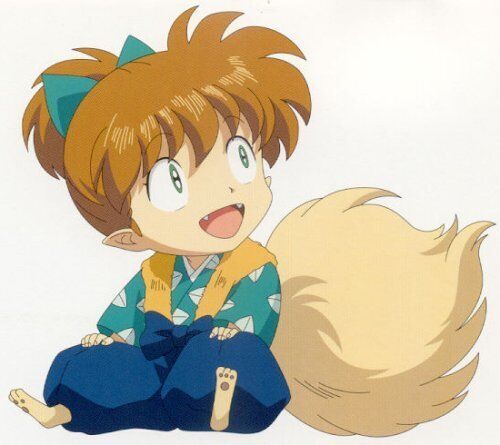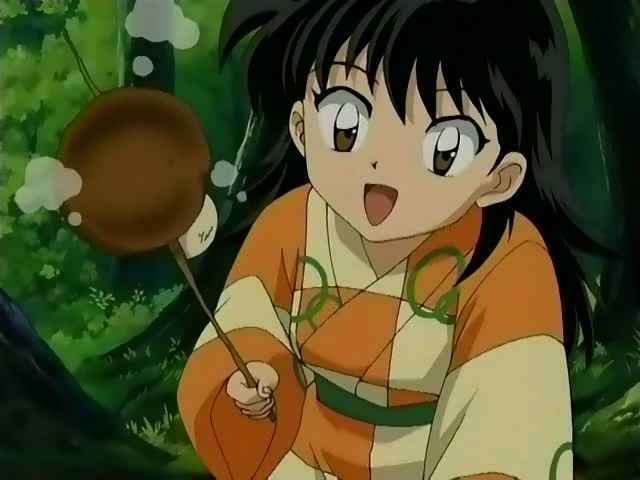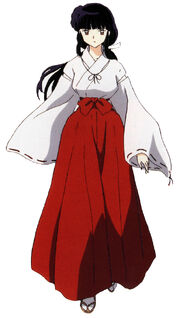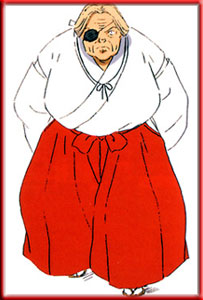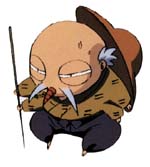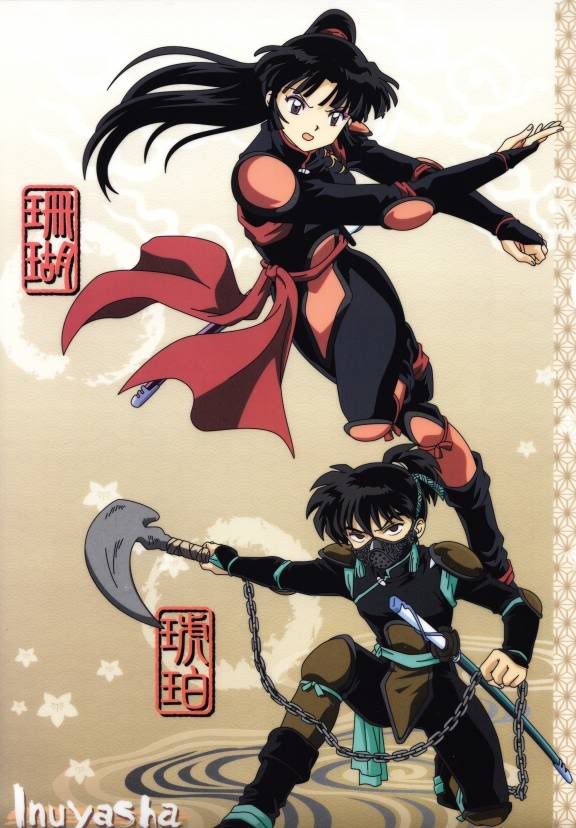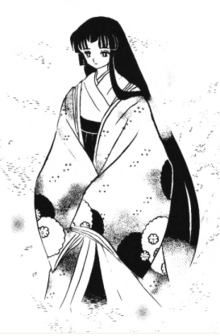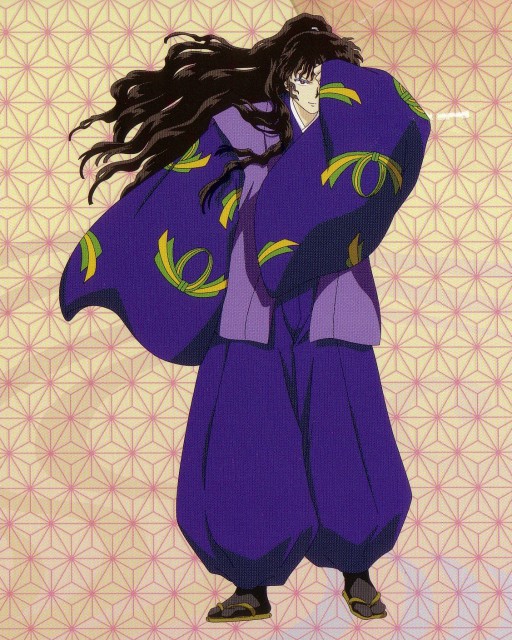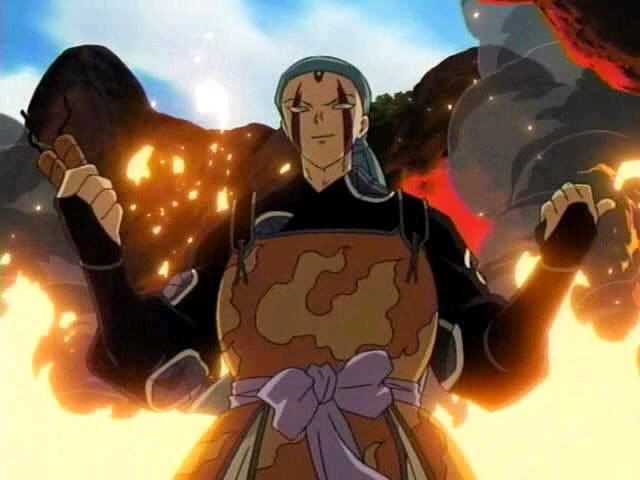My main forum, Glossary of Japanese Clothing, actually ran out of room for further modifications. In celebration of this, here's a forum JUST for the clothing of the Inu-Yasha characters! 8D Please feel free to make requests on characters and outfits, and feel free to make civil arguments about the clothing (citing sources would be very useful as well).
PICTURES: If a link does not work, please tell me! Particularly if you're a minor, because some image searches can result in nudity and profanity.
BLANKS: Will be filled in later. Making this already took quite a few hours, on and off.
 Some awesome and helpful reference sites
Some awesome and helpful reference sites:
A lot of my information comes from books, but these sites are very helpful and safe to browse:
--->
Sengoku Daimyo: This website is very thorough in the entire culture of Japan, and the clothing section is amazingly informative.
--->
Rebirth of the Tale of Genji: The Costume Museum: A little tricky to find things, but very informative and lovely to browse.
Words of clothing may vary, but that is to be expected in every language since clothing can be named based on: material, dye, cut, thickness, added features, status of individual wearing it, the order in which the clothing is worn in an outfit, job title of wearer, occasion, ect.
--- § ---
Glossary of Japanese Clothing:
Inu-Yasha Characters
Index
(You may search for a section by typing in the number proceeding it. Ex: Inu-Yasha, search by '1.1')
::
List of the Basics ::
Fundoshi/Yumoji
Sarashi
Yukata/Kimono
Types of Juban
Types of Footwear
Tabi
Koshihimo
Kimono + Hakama
::
1 - The Protagonists ::
1.1 Inu-Yasha
1.2 Kagome
1.3 Miroku
1.4 Sango
1.5 Shippo
::
2 - Sesshomaru's Group ::
2.1 Sesshomaru
2.2 Jaken
2.3 Rin
::
3 - Supporting Characters ::
3.1 Kikyo and Kaede
3.2 Myoga
3.3 Totosai
3.4 Kohaku
3.5 Koga
::
4 - Minor characters ::
4.1 The
Inu no Taisho
4.2 Izayoi
4.3 Sesshomaru's Mother
4.4 Ayame
4.5 Jinenji
::
5 - Antagonists ::
5.1 Naraku
5.2 Kagura
5.3 Kanna
5.4 Muso
5.5 The Infant
5.6 Hakudoshi
5.7 Moryomaru
5.8 Byakuya
5.9 Band of Seven
5.9.1 Kyokotsu
5.9.2 Jakotsu
5.9.3 Mukotsu
5.9.4 Renkotsu
5.9.5 Ginkotsu
5.9.6 Suikotsu
5.9.7 Bankotsu
--- § ---
:: List of the Basics ::
Fundoshi/Yumoji - These are underwear.
Fundoshi come in many styles and are normally worn by men.
Yumoji are for women, but don't really do much for the wearer.
Sarashi - A long strip of white cloth, it is normally used to bind the breasts and create a more slim figure, which is desired for a
kimono.
Yukata and Kimono - The general garb of choice. Always visible from one perspective or another.
Kimono are usually fancier and festive,
yukata are everyday wear and normally lighter in fabric with less layers.
Types of Juban - Anything with the word
juban in it implies the fact that this garment is worn under something else. A
nagajuban is like a
yukata, but a little longer and worn underneath. A
hadajuban means that it's a
juban (ex:
nagajuban) which directly touches the skin, taking the soiling in place of the rest of the outfit. A
hanjuban is a half-length
nagajuban, a little below the waist in length.
Types of Footwear:
Geta - Sandals made with elevated wood supports. Men's geta are square, women's are more oval and are called komageta.
Setta - A flat, thick bottomed sandal made of bamboo bark and straw with leather soles.
Waraji - A traveler's sandal, made of straw and bamboo bark and designed to wrap securely around the wearer's foot and up around the ankle.
Zori - A dressy, oval, short heeled sandal consisting of either straw or lacquered wood and thong straps made of fine fabric, typically silk. While being worn, the wearer should notice their last two toes hanging over the zori. This is normal. Notice the traditional heel, do NOT get caught up in modern zori images if working with historically accurate material.
Tabi - Split-toed (separate big toe from the rest) socks which originally tied around the ankle (no clips). Normally white in color. Designed to allow the wearer to slip into shoes. The interior fabric is highly durable to handle the wear and tear of daily use. Taller
tabi, still originally tied shut, are called
jika-tabi.
Koshihimo - A basic strip of cloth used to tie a variety of things, usually for underlying layers of clothing.
Kimono + Hakama
I'm about to contradict myself from my other glossary in a very peculiar manner (and this admittance will be erased once I go and edit the other version). There is a style of fold that men can give their
kimono, called the
shirikarage. This is when they take the hem, gather it up, and tuck it into the back of their
obi. The original one I had seen had this fold lifted up past their thighs, making it bulge out quite a bit due to the ankle-length fabric being gathered in such a short space. There's a
second nature to this fold though, where you lift up only enough fabric to make a knot of it of sorts above the
obi. Because of this less fabric is required, and the kimono ends up hanging around the knees, leaving the fabric around the hips still smooth. This means that full length
kimono can be worn with
hakama! The clothing listed below will be modified from the original post for this second fold style.
--- § ---
::
1 - The Protagonists ::
(From right to left: Inu-Yasha, Kagome, Miroku, Sango, Shippo)
1.1
Inu-Yasha
So, to be perfectly honest, no one knows what the heck he's officially wearing (no real name for his upper outer layer), but I'll give you my best guess and an explanation. So, underneath,
fundoshi and an off-white
hanjuban (or
nagajuban lifted into
shirikarage). His outer firerat top, commonly called a
haori in fanfiction, most closely resembles a
hitatare.
Supportive points for this garment being a
hitatare as opposed to another article of clothing:
1 - White at Inu-Yasha's hips: This white is his hanjuban showing from the slit of his hakama (refer below). Because it's white and not red, this means that his outer top ends at the tie of the hakama. Haori are too long to offer that and cannot properly adopt the shirikarage tuck at that length.
2 - The collar and the 'bulge'. For this garment to be shut, it would require going against its stitching. Considering that Inu-Yasha is an impatient ignoramus it's not unlikely that he'd yank the garment improperly shut, tie it into place with the hakama, and then just deal with the excess fabric he has over his chest (kinda makes him look like he has breasts in the manga).
3 - The slits in the shoulders of the garment are traditional for hitatare, not for haori though.
4 - The string on the chest. It's customary with hitatare.
5 - The sleeves and sode-kukuri. The sleeves are the proper size and style, which is unique.
6 - It has been argued that his top could be a 'han-suikan', or half-lengthed suikan, but there are a few other problems with this. The tie in the front is similar, but attaches near the armpit as opposed to the waist. There are negative points for the garment's (a) natural length, (b) split-panel front (hence the light blue 'shoulder slits', which they're not), and (c) the high collar of the outfit. If you want to though, it isn't a terrible idea to take the best parts of the suikan and the hitatare by calling the garment a suikan-hitatare. It came from a yokai, so why not?
Okay,
hakama. This is the same for Shippo and Sesshomaru. They are called
sashinuki hakama/nu-bakama and are difficult to put on:
image (this is just a general reference). This style of
hakama billows at the lower leg, and are tied around the ankle to encourage the poof. Examples online look a bit different than what we see in the series, but Shippo and Sesshomaru have the excuse of their clothing being altered by
yoki. For Inu-Yasha, please use some creative license.
* Another suggested top for Inu-Yasha (and one which would carry over to the clothing of the
miko in this series thanks to their altered clothing) is the
hitoe erratta. Google it and you will ONLY find the forums based off of Inu-Yasha's outfit. Because of this I'm not justifying the fabric because I want visual proof or an actual scholarly paper describing it. Feel free to use it though.
1.2
Kagome
Throughout the series Kagome wears a
seifuku (sailor uniform), which can be designed for
summer or for
winter. This consists of a pullover shirt with a square backed collar that hangs off the shoulders on the back and meets in a v-neck on the chest, as scarf and a pleated skirt. She completes this outfit with calve-high socks and
penny loafers. The under layer (anti-cleavage fabric) may be an undershirt but it is usually sewn to the inside of the pullover shirt. She most likely wears a bra and underwear as well, but since we never see these it's up for debate.
--> For her
miko garb, please see 3.1 Kikyo and Kaede.
1.3
Miroku
In order of dress:
fundoshi (underwear),
nagajuban (under layer, protects outer layer), formal
kimono (longer sleeves, but not a
furisode),
kataginu (the purple wrap, a Buddhist garb), one
tekko on his cursed hand. His footwear consists of
tabi (socks) and
waraji (travel sandals).
-->
Shakujou - A traveler's staff, typically wood but may be fully mental, topped with a metal ornament and may possess a series of rings, which are used for different reasons depending on the user's background in Buddhism. The jingling of the rings is to warn sentient beings of the traveler's presences and to allow the traveler to avoid having to defend themselves or from having to accidentally take life (like that of a small creature or an insect) while they walk.
Shakujou with religious function, since they were common in the hands of everyday travelers, may have either four rings, six rings, or twelve rings. Four rings represent the Four Truths of The Nobel One, six represent the Six Perfections, and twelve represent the twelvefold chain of cause and effect. In Miroku's case, his
shakujou has six rings. Practitioners of Shugendou, a branch of Buddhism which takes its practices to the mountains, favor the
shakujou as a self-defense weapon. In fiction, the
shakujou is seen channeling spiritual powers (
ki) and in assistance with Buddhist spiritual barriers (
kekkai) or spells.
-->
Japa mala - A chain of beads,
japa mala are commonly used by Hindus and Buddhists. The typical number of beads is normally 108, but may vary (usually divisible by 9). Wikipedia provides a
good reference for this.
Japa mala assist in prayers and chanting, mainly for focusing one's mind and
ki.
1.4
Sango
This girl breaks the bank in terms of her clothing. She has so much of it that I'm giving Kohaku the
taijiya wear (for that, please see '3.5 Kohaku').
Casual Wear: I don't believe she wears her
taijiya fuku under her relaxation clothing (if she did then she's one resilient woman). She most likely wears a
yumoji,
sarashi,
hadajuban (because we
can't see the eri [collar], which is common for this garment when worn with regular
kimono), then her cute
kimono. The green apron is called a
maekake, and her footwear is
waraji. We also see black fabric around her ankles and wrists. Around her ankles she is wearing the
ashi-goshirae. Around her wrists are her
tekko, which probably means that her hidden blades and
kusarikatabira remain on as well. We also see in the above picture that she uses a
furoshiki, a long cloth used to wrap items, or to strap, cover, and tie things (even infants) to someone's torso, typically onto their back. By my guess Sango carries a lot of her armor there when not wearing it, and her sword is hidden... someplace, I'm not even going to guess, this woman scares me sometimes.
 Weapons
Weapons: This is a video link. It demonstrates the main uses of her weapons beautifully, and kinda scares the living daylights out of me.
Hiraikotsu: Her gigantic boomerang. Made from the melted down parts of defeated
yokai, this weapon is given a special attribute later on in the series, the ability to cut through
yoki and to poison its victim(s).
Wakizashi - a sword which is designed to be a little shorter than a
katana, which is ideal when drawn in close proximity to an opponent.
Hidden Weapons: This fearsome fighter has blades hidden under her
tekko and over some lower arm
kusarikatabira (chain mail). She also uses special poisons stored about her person.
1.5
Shippo
This adorable puff-ball is wearing quite the impressive little outfit, particularly for someone his size. In order of wear, he has
fundoshi (some little boys would wear only those in their villages throughout the day), a
hanjuban, his light blue
happi coat (devoid of
mon [clan crests]), and the billowing
sashinuki hakama/nu-bakama. He, being a full-blooded mammal
yokai, was also born with a pelt (by my theory) and now wears it as a vest.
--- § ---
::
2 - Sesshomaru's Group ::
(From left to right: Sesshomaru, Rin, Jaken
2.1
Sesshomaru
I guess he's allowed to be complicated, considering he's had centuries in which to plan his outfits... A bit of his clothing has mainland (Chinese) influence. For those garments I'll write (mainland influence).
Underlayers:
Fundoshi,
hanjuban (high quality not only for his title but also because the fabric is firm and thick in the fold, so probably layers of silk around the
eri (collar) at least).
Top Outer Layer: This article of clothing was either specially made to be more convenient, or Sesshomaru takes an obscure step in dressing himself. If you agree that the top is specially tailored, I recommend calling it a '
hankimono' (literally, a 'half-kimono'). If you say it isn't, then he is wearing a full length
kimono in
shirikarage style (lifted to tuck into the back of the
obi. Unfortunately, if you image search for "
shirikarage" you will only be taken back to this webpage [reputable, no?]). This '
kimono' is cut in the formal style (like a
hoshi's [Miroku's] may be, according to sleeve length).
Bottom Outer Layer: Sesshomaru's
hakama have two different names, and none of the examples will look like his, but oh well. This
hakama was specifically reserved for courtiers, and went by either
sashinuki hakama or
nu-bakama, which I don't know the difference between yet but here's some pics regardless. They tie at the ankles to allow the fabric to gather over the wearer's feet. By all
appearances, the fabric is highly starched, making it rebelliously poof out away from the body, and to make it strong against the overlying weight of other clothing these
hakama are most likely made with a thicker material as well, such as a double layer of cotton as opposed to the common use of linen.
Boots - (mainland influence) These snugly fitted boots resemble
tabi socks, and for this reason they are most likely made with flexible material and designed to tie shut in a short wrapping fashion (which would be hidden under his
nu-bakama, which tie over the boots).
Accessories. Yes, he has 'accessories', and dear lord plenty of them. Instead of getting terms lost in a paragraph, here they are by list and description:
Armor:
Sode - Shoulder armor, but Sesshomaru's is highly specialized. Also known as 'pauldron'.
Do - The torso armor. Also known as cuirass.
Kusazuri - Waist armor. Also known as 'faulds'
"Fur" - Commonly referred to as 'mokumoku', it is also common to see it titled as a 'pelt' or even a 'boa', and has been portrayed as the skin of some other animal. My take on his fur is that he was born with it, hence his connection to it (able to use it in combat, its ability to bleed (third movie, when Sesshomaru gets stabbed during a flashback) and its appearance on him in his true form fitting along where he wears it). I personally have a whole inuyokai culture associated with it, but it would be irreverent to put it here (feel free to peruse my fanfics, heehee).
Sash - (mainland influence) There IS a "soft obi" or heko obi (in the pic you can see he's wrapped that darn thing around him about three times), and you can very well call this sash by that term and be perfectly valid in doing so. In fact, if you want a Japanese term for that silk scarf sash then heko obi is the one to use. However, heko obi do not go past 9.5 feet in length and his sash is incredibly long. If I were to guess, it is approximately twelve to fourteen feet in length. It first ties around the armor at his waist (2 feet), holding his weapons, then elaborately curtains down to either thigh (3 feet x2) and THEN has the long hanging strands out front (2 feet x2). It also has a unique and very detailed pattern to it, something that the classic dying methods would have some qualms with (tie-dye, actually, which you could say shibori for as a translation), so I prefer just calling the ridiculous thing a 'sash' and getting it over with. Dying that silk took a LOT of patience and talent, and most likely a paintbrush and many, many tears of frustration... Anyway, I'm far too picky for my own good... Curse your wardrobe, Sesshy! Even if you DO look fine in it!  Oh, and another reason why I state that it may have mainland influence is because he keeps the thing tied in the front... I don't know why Takahashi torments us like this but anything around the waist that ties in the front basically highlights a prostitute (easy access anyone? Yeah, I can see the fangirl hands raising now). Men, in Japan anyway, keep sashes and obi tied at the back or, sometimes, to one side (but that gets in the way of swords and swinging arms so it's more of an 'at home' knot). Yeah, I vote mainland influence over Japanese prostitute, particularly since most of us thought he was a woman when we first saw him. (hehe, good times.
Oh, and another reason why I state that it may have mainland influence is because he keeps the thing tied in the front... I don't know why Takahashi torments us like this but anything around the waist that ties in the front basically highlights a prostitute (easy access anyone? Yeah, I can see the fangirl hands raising now). Men, in Japan anyway, keep sashes and obi tied at the back or, sometimes, to one side (but that gets in the way of swords and swinging arms so it's more of an 'at home' knot). Yeah, I vote mainland influence over Japanese prostitute, particularly since most of us thought he was a woman when we first saw him. (hehe, good times.  )
)
*
Maintenance of Clothing and Armor: I am a full believer that he is capable of using yoki to mend his clothing. Why? Because first off, his clothes have been ruined (unfortunately, never completely destroyed) throughout the series and by the end we should have definitely seen blood stains and stitches and dents and other such things. Secondly, I can not see him taking the time to go and have someone repair the clothing or armor. Thirdly, due to aforementioned damage, I refuse to believe (or at least desperately hope to the contradiction) that his closet is bigger than mine for the sole sake of having duplicates of everything.
I just really like this picture...

It helps remind me that he doesn't have to be a frowning stiff all the time. Plus, it really shows off that
hanjuban collar. While I have his face in your face though, I'd like to comment on his markings. I get specific in his mother's section (4.3) on why I'm pointing this out but notice that his cheek and eye (and
wrist) markings all match in terms of color, but the crescent moon doesn't. O-ho?
2.2
Jaken
Hopefully you find this as funny as I do: He is dressed, minus the coloration, almost exactly like a
Kannushi (Shinto priest). Anyway, his inner top layer is, again, a
hanjuban, his outer top is called a
kariginu (originally part of a hunting outfit from the Heian Period). His hakama are, as you may have guessed,
sashinuki hakama/nu-bakama, and his hat is something akin to the
eboshi.
2.3
Rin
Rin's outfit is very, very, very simple, and very appropriate for an orphan. It consists of only one layer: child's
yukata, devoid of
tamoto (the hanging part or 'pocket' of the sleeve), fastened shut with a simple
obi, perhaps even just a
koshihimo.
--- § ---
:: 3 - Supporting Characters ::
3.1
Kikyo and Kaede
Shinto
miko (priestesses/maidens) traditionally wore the following items, from inner wear to outer wear:
Susoyake (aka koshimaki) - a
wrap-style underskirt which ended short of the ankles and prevented the miko's feet from becoming tangled in the next layer to cover her legs.
Hanjuban - a wrap-style shirt which ties to the right hip and is made of a thin linen material which is slightly see-through and consists of short sleeves and small armpit vents, ends at the waist a few inches below where the
susoyake starts.
Hakui - The long white
kimono-like robe which ends around the ankles and is tied into place around the waist with a length of fabric (commonly called a
koshihimo).
Andon-bakama - Named for its shape's resemblance of a Japanese paper lantern (
andon), this garment is worn over the
hakui. This garment is more like a skirt,
NOT hakama (which have divided legs). When the reader knows that a
miko is the subject of conversation it's then fine to say the general term
hakama since they can fill in the description (
andon-, hi-) themselves. Always red in color (therefore also known as
hibakama) this layer is somewhat pleated, giving it a semi-pleated appearance.
This style of
hakama splits its skirt (
from the knee up) into a front panel and a back panel. Both of these halves sport long thick strips of fabric called
himo for securing the garment, and a
firm yet flexible supportive board across the back called the
koshi-ita to keep the fabric from rolling with wear. Actually tying the garment in place gets too tricky to really bother with explaining (not for a lack of trying...). Here is a visual aid for tying on the
hibakama in a traditional manner (and I have no idea how the clothing stays in place on the side of her we can not see, perhaps the straps are connected on one side:
image
Footwear:
tabi and
zori.
Hairstyle - A
miko's hairstyle signifies her rank. Those with unbound hair are
jokin (apprentices) who may serve as part-time assistants for a shrine.
Ordained miko wear their hair pulled back, and may wear a hair ornament of
washi (white handmade paper) strips tied on by braided red and white (ceremonial colors) cords called
mizuhiki. Keep in mind that while these
mizuhiki are braided for thickness, it's done so with one color per braid, not intermixing the red and the white.
Image) of formal event. Here is an
image of just the
washi, worn by Kikyo.
* As exemplified by Kikyo,
sode-kukuri (cords) may be woven through the hems of the sleeves for decoration, and a
muha-himo string may be looped around the neck (but its purpose is to attach to the
eri (lapels/collar) of the garment and tied together to help keep the garment shut), which leads to the following item:
** The
chihaya, reserved for ceremonies, is worn as an outer, large-sleeved robe which ends at the knees over the
miko garb, and requires the use of
muha-himo to keep it in place. Here is a link to an ordained, traditionally garbed
miko wearing the
chihaya for visual aid:
image
---> Rumiko Takahashi did not give her characters traditional
miko clothing (in fact, most people don't, it's a friggin' hassle and you can not move quickly in the proper garb, nor ride a horse). Instead, she gave them 'pants' (a style of
hakama called either
machidaka-hakama or
umanori-hakama, which are differentiated depending on whether they have a high
koshi-ita against the wearer's back or are designed for riding horseback [respectively]). In case you did not catch yet the reason for why this disrupts the entire
miko outfit, it's because of the fact that you simply can not wear a
hakui and
susoyaki under 'pants', and considering that it's two layers to work with that negates the
shirikarage fold. It can be done without the
susoyaki, but we don't see the knot made by the
shirikarage fold going over the (in this case)
koshihimo tie either, so it's your call in the end. Time to start being creative. To protect the clothing, a woman can wear a
yumoji (women's 'underwear') and the
shirikarage fold can be achieved with that on. Then come the
hakama. Rumiko also gives her
miko tabi and
waraji.
3.2
Myoga
3.3
Totosai
3.4
Kohaku
His relaxation clothing is very simple: a modified (sleeveless)
happi tied shut with a
koshihimo. The white cloth around his wrists and ankles may be seen as four pieces of one whole
sarashi.
Taijiya fuku: "Demon Slayer" Clothing. While it is always possible to make these outfits more reasonable (spandex (gotten by any means),
yoki imbued fabric, magic, etc.) if we were to be 'realistic' then these body suits would either be made of a close-stitched (shaped even around Sango's breasts) dual layer cotton or
a thin and highly worked leather, which would be super hot (temperature-wise). You could even say that these suits are made from the hides of a certain type of
yokai. If you're interested there is a youtube video for leather thinning I recommend watching if you want to see how to 'traditionally' thin (par) leather, as a tanner (prepares leather) and tailor (uses prepared leather) would have done in the
Taijiya Village. I've tried adding a link but the whole darn video pops in, so search for 'Paring the leather' on Youtube and click the first result (2 minutes 11 seconds long) if interested.
No matter the material, and despite the
Chinese-style front of their clothing, in order to get that 'conform to skin and hardly wrinkle' look Sango and Kohaku would have to
discretely lace-tie behind their legs from mid-thigh to ankle in order to get their calves in the suits past the tapered knee point. Depending on the position of their limbs though, whether it's leather or cotton the material would
wrinkle terribly, so magic (or spandex) is a good default choice for this outfit, especially since the collar of the
taijiya suit does not appear when Sango is wearing casual clothing, so when she tears off the casual (absolutely amazing....) her fighting attire just sort of appears (this is me referring mainly to the first movie).
Armor: You ready for this? 8D Western words are also provided.
"Couter" - Elbow armor. This is a unique item and did not appear in the classic samurai armor.
Sune-ate - Shin armor. Also known as greaves.
Sode - Shoulder armor, but Sango's is specialized. Also known as pauldron
Kogake - Foot armor (may be worn under her 'boots', but a fabric covers her feet all the way up to mid-shin. Aka: sabaton
Kyahan/Kiahan - Fabric worn under the sune-ate armor to protect the skin.
Tekko - Worn over the lower arm, this is a fabric or arm guard (kote) with hand armor and other such features built into it. In Sango's case she uses it to store hidden blades as well as what appears to be a simple chain mail.
Uwa obi / Himo - Sango's sash, but the traditional appearance is a lot more simple. Specifically designed to hold armor and weapons in place.
Kusazuri - Waist armor. Also known as 'faulds'
Kohaku's Weapons:
Wakizashi - a sword which is designed to be a little shorter than a
katana, which is ideal when drawn in close proximity to an opponent.
Kusari-gamaKusari-gama - A scythe attached to a long chain with a lead ball weight at one end. Chain may be longer or shorter depending on user's tastes.
3.5
Koga
He seems a little annoyed to be in this. Oh well, he can play my fashion victim. :3 So, just because it's Koga, I'm tempted to say that he doesn't wear
fundoshi (underwear), and instead just lets himself, for lack of a better term, hang loose. On that note, whatever is under his fur is up to your jurisdiction, but I'll try to be as complicated as possible and let you simplify from there.
Armor: His breastplate is called a do, but since it doesn't resemble one I'd either call it a breastplate or a cuirass (2.1 Sesshomaru).
Fur (pelt): That's how I regard the fur around his waist, to which I also assume his tail is attached. Again (my theory, feel free to argue) I believe he was born with it as part of being a full-blooded mammalian yokai.
'Furry Accessories' (and weapons): He has his headband, then there's that odd bit of fur around his (from his perspective) right wrist. If you look at it closely it's a slightly different color than the rest of his fur. Personally, I believe that it's a memento/remembrance for one of his parents, and as a part of his ancestors it disappears or becomes part of the Goraishi. This is just one fangirl's opinion.  In reality it probably just gets covered by the Goraishi, but we may never know. His sword is formally known as a katana, which is longer than a wakizashi.
In reality it probably just gets covered by the Goraishi, but we may never know. His sword is formally known as a katana, which is longer than a wakizashi.
'Furry Armor': I'm tempted to say that he has kyahan and sune-ate (armor, 3.4 Kohaku) under the furry ashi-goshirae (1.4 Sango) around his lower legs, part of a kote under the furry tekko (armor, 3.4 Kohaku) of his left arm, and well as sode (armor, 3.4 Kohaku) under the fur on his shoulders, which would explain why they are lifted slightly higher than you'd expect (fur is flexible and thin in skin, it should be misshapen). As a side note, there are sarashi wrapped around his feet and probably a good distance up his ankles as well.
--- § ---
:: 4 - Minor characters ::
4.1 The
Inu no Taisho
It is...
sinfully...
difficult... to get a decent image of this guy's outfit... The second one isn't even officially from the
anime or
manga, but the artists (
Narya13 and
john-the-artist) put a lot of work into the accuracy of this image and I admire them for it.
So, on with better things: The
Inu no Taisho's clothing is actually quite unique in terms of the top outer layer. To portray wealth and status it was common in Japan to wear layers and to have long sleeves (more fabric means more money). Here, that is not the case. On a general note (and to save on forum space) I highly recommend basing his clothing off of Sesshomaru's (2.1). There are key differences though:
- The Inu no Taisho's top outer layer is a modified kimono by means of not having tamoto (hanging sleeves). This fact allows the Inu no Taisho to easily secure his kote (lower arm armor, though it definitely has been influenced by mainland armor) around the excess fabric of his sleeves, giving his arms the unique tapered appearance.
- His sash is of mainland influence, but its length is either the same as Sesshomaru's and just wrapped around his waist several times, OR it's closer to six feet in length (2 feet around the waist, two trailing ends down the front at 2 feet per end).
- His hair is tied back (so sexy...) with stiff cords of braided mizuhiki.
- Fur/'pelt' - The Inu no Taisho wears his down his back and it splits near the end into two bits/tails. This compliments his true form's appearance with the split wings of fur coming off of his shoulder blades and the way it attaches around his neck.
- Inu-Daddy really knows how to present and has quite a bit of armor. By its design and appearance, in total it probably weighs close to sixty pounds, and that's not adding in the weight of three swords.
Armor:
Sode - Shoulder armor. Very large, long enough to require a second fastening around the upper arm. Also known as 'pauldron'.
Do - The torso armor. Also known as cuirass.
Kusazuri - Waist armor. Also known as 'faulds'
Kote - Armor for the lower arm, traditionally attached to a sleeve-like section of cloth. Also (and perhaps better) known as a vambrace.
Something I've notice which sort of annoys me is that the
Inu no Taisho's armor completely changes when we see it on
his remains.
That style is more consistent with the
traditional Japanese armor, and by all means all of that metal should have bankrupted Sesshomaru's whole family line... Most buildings these days don't even come close to having that much because it's so expensive, and to actually heat and shape it-! I'm blown away, and I'm never coming back to that topic, haha.
4.2
Izayoi
Izayoi is (probably) the most fancily dressed of all the characters that I'll be covering in this, and her clothing actually gives plenty of promising notions about her character's background, as does her
very long hair (something they had
wigs for). Her style of dress can be associated with many titles, but most pertain to ladies of the court. To see Izayoi's outfit, click
this link and search for:
itsutsu-ginu ko-uchiki. This is the image you'll see:
Familiar, isn't it? It makes me all

to see it! FYI, in the picture this figure is holding a fan. Anyway, here are the layers:
1. Hadajuban - a kimono-like layer to protect the rest of the clothing, reaches to ankles and has shorter hanging sleeves.
2. Kosode - A simply type of kimono with shorter tamoto (hanging sleeves) and a simple appearance.
Nagabakama - Yes, they could walk in that. A style of hakama, it was specially tailored to trail behind and to not be stepped on. You can also call them aka no hakama like they do in the link I posted for the above image. Because this outfit includes a style of hakama the wearer does not require an obi, and in this case forgoes it completely.
*(For the rest of the layers, which are all unbound (no obi), please visually refer to the image below, it gets confusing.)
Hitoe - Imagine a kimono that's too long in every direction... It sticks out at the sleeves, shows at the front, and is the layer to trail on the floor behind the wearer. It's fancy, but int's a sacrificial piece and will take all the wear of walking around.
Kinu (or uchiki or istu-ginu) - Thin, large, kimono-like layers. Notice in the picture that light shines through easily, but when they're layered they are quite thick. There can be several layers depending on one's status, and Izayoi wears three.
Ko-uchigi - The final touch, this layer is of very high worth and usually made of the finest of material.
4.3
Sesshomaru's Mother
The stoic mother of the stoic Sesshomaru. She's like her son in a lot of ways, but I was highly impressed by her tolerance for humans and her acceptance of the idea of her son loving Rin (as a daughter I think, but that's left open), even if it's to make a point that he was not a
kami (deity) and that death was something to fear, even with Tenseiga in his possession, for the sake of sorrow and fear, two things he never really felt. I have great respect for her, because while she can be cold and devoid of many expressions she is very logical and impressively open for a
yokai. Also she gets exasperated with Sesshomaru and can get up in his face a little to mock him, which is healthy for him, heehee.
Okay, that last paragraph wasn't about clothing (which you can see for yourself in
InuYasha - The Final Act, season 1, episode 9, presently offered on
Hulu.com). Surprisingly enough, despite her status (and impressive floating
o-shiro [great castle]) she is very modestly dressed, her outfit less impressive than Izayoi's. We never actually see the midsection of her clothing, so I can't say for certain exactly how informal her attire is (there's no bulge to indicate the
honobi otaiko at her back, so she probably doesn't wear one), but by all appearances this is what she's wearing in order of wear:
Hadajuban - Touches the skin, is infrequently. Tied shut with a koshihimo. Usually this is seen at the eri (collar), but in her case since the innermost layer that we see sticks up prominently around then neck I'm saying that:
Nagajuban - She is wearing two of these, one of them with a white collar and the second with a blue patterned collar (signifying that it's fancier). Wearing two is not uncommon, and may be seen as a symbol of wealth or simply as a need for more warmth. Each is tied shut with a datemaki (under-obi).
Kimono - The layer in possession of the third and final eri around her neck. Since all of her eri are set further than the traditional spacing, it is possible that to hold her layers together she has loosely knotted an obi around her waist, or that the eri spacing was intentional and she is wearing a traditional honobi underneath (with a very small otaiko or none at all).
Outer Layer: This is something that I can't find a reference picture for online. For the sleeves, order of wear, loose and low hanging qualities, I'm calling this a shikake. With fur trim. This garment is a type of uchikake, and was originally worn by members of the bushi (samurai class) before being adopted by high-ranking oiran (a courtesan, which is not the same as a geisha). It is designed to allow excess fabric to trail slightly behind the wearer. Her pelt is attached around the collar and around the hem of this garment.
Footwear: It's up to you, but I'd say she wears tabi (which would require that she keeps her toenails well groomed).
Accessories:
Hair ornaments: I like to think of these as mating gifts from her late mate, which ties into my belief that once an inu is mated they keep their hair pulled up (hence why Sesshomaru wears his down whereas his parents wear theirs up). Just an interesting idea, use it if you'd like.
Meido-Stone: This is the name of the necklace she wears.
Markings: Similar to Sesshomaru's in, but different along the cheeks. Hers are very subdued and elegant as opposed to her mate's. How Sesshomaru got two I have no idea, but I associate the cheek and eyelid markings as something from birth, along with those found on Sesshomaru's (I didn't see any on his mother's wrists) and possibly elsewhere. The crescent moon on the brow, considering its shape and regularity between these three, I consider as a mark given upon birth or when one mates into Sesshomaru's family line, a tattoo of sorts (which isn't an injury so it wouldn't be 'healed', per say).
* As a special note, she is living proof that yokai can and do wear makeup if they so desire. Her lips are painted, and her claws are lacquered to match the color on her eyelids.
4.4 Ayame
In general, her outfit is exactly like Koga's so you can easily cross-reference. All I want to point out though is that she has
no tail, so in my opinion her proper fur/pelt is actually draped around her shoulders.
4.5 Jinenji
--- § ---
:: 5 - Antagonists ::
5.1 Naraku
[img]http://www.rubberslug.com/img_show.aspx?ImageID=223286&X=530&Section=Item[/img]
5.2 Kagura
5.3 Kanna
5.4 Muso
5.5 The Infant
5.6 Hakudoshi
5.7 Moryomaru
5.8 Byakuya
5.9 Band of Seven
(From left to right: Kyokotsu, Mukotsu, Jakotsu, Bankotsu, Renkotsu, Suikotsu, Ginkotsu
5.9.1 Kyokotsu
5.9.2 Mukotsu
5.9.3 Jakotsu
5.9.4 Bankotsu
5.9.5 Renkotsu
5.9.6 Suikotsu
5.9.7 Ginkotsu








